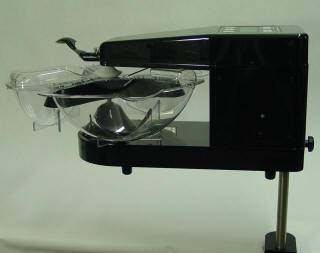Mealtime Partners, Inc.
Specializing in Assistive Dining and Drinking Equipment
September 2017 Independent Eating and Drinking Newsletter

|
September Topics:
|
||
|
Mealtime Partners Home Page Send a Comment or Suggestion |
|||
The primary purpose of eating is to provide our bodies with nutrition and calories for energy and growth. Also, eating is often a social occasion when family and friends spend time together. However, within this framework it should be remembered that eating, and to an even greater extent, feeding oneself, requires energy to be expended (i.e., calories are both being acquired and being used by the same activity). For that reason, we should always be aware of the level of effort that is being put into eating so that the activity does not burn too many calories and thus reduce the benefit of the total calories consumed. If someone is using a lot of energy eating, their ability to sustain the effort will no doubt cause them to fatigue. This article will provide a brief overview of factors that contribute to fatigue at mealtimes and how the fatigue might be reduced.
Many people feel sleepy after a meal but there is a big difference between being sleepy and being fatigued. For people who fatigue easily during a meal there is normally an underlying medical condition that causes the fatigue. The average person eats without exerting enough effort for them to be aware that they are expending any energy. As we learn to feed ourselves as infants, we develop the muscle strength and coordination to make eating easy and, for the most part, automatic.
The most obvious reason that someone fatigues quickly at mealtimes is that they are frail. Both the elderly and individuals with degenerative conditions exhibit rapid fatigue. It is recommended that for these individuals, mealtimes be abbreviated and meals supplemented with nutritious snacks. Therefore, that person will be provided three small meals that can be consumed in fifteen minutes or less, and the meals will then be supplemented with three of four snacks, depending upon the number of calories that are needed to sustain the particular individual. Furthermore, within this scenario, the eating/feeding practices can be modified to conserve energy. Half-way through the meal the caregiver can provide more assistance either by helping load the utensil or by offering to feed the individual. Also, food preparation can contribute to reducing the level of effort that is required to feed oneself. If meat is cut into very small pieces then it can be picked up easily with either a spoon or fork and will require less chewing before it is ready to be swallowed, thus, less energy is expended by the person eating.
For many people, the physical exertion required to go through the steps needed for self-feeding are extremely demanding and will cause rapid fatigue. If muscle control and coordination is difficult, executing the complex task of picking up food and bringing it to the mouth can be exhausting. For those who fatigue rapidly due to the demands of muscle control, various approaches can be offered. As mentioned previously, one approach is to shorten mealtimes. Instead of three meals a day, five smaller meals can be provided. The provision of small meals provided more frequently, reduces the demands on muscles for extended times. (However, the logistics of doing this is difficult for some people, particularly children in school or those who reside in an institutional setting where scheduling food for times other than set mealtimes is difficult.)
Another approach to reducing fatigue due to muscle coordination demands is to reduce the number of movements that are required for each bite of food. For example, supporting the individual’s elbows and forearms stabilizes the arms and makes moving food from a bowl to the mouth easier.
Also, in some cases, if the individual only eats what food they can until they start to fatigue, it helps the mealtime to be enjoyable and stress free. At that time a supplemental drink can be offered to provide the additional calories needed. It requires much less effort (i.e., energy) to drink than to eat. Mealtimes should be enjoyable and relaxing and if someone is “pushed” to continue eating once they are tired, the mealtime pleasure is quickly removed.
Fatigue occurs more rapidly if someone is unwell. For example they have a cold. Also, if effort has been expended on an activity prior to the meal, the individual will become tired sooner.
All of these factors should be considered to make appropriate mealtime accommodations for those who fatigue easily due to self-feeding or eating. For those who fatigue very rapidly due to the effort of self-feeding, assistive technology should be considered to reduce the effort expended during meals. Equipment like the Mealtime Partner Dining System can enable people to continue feeding themselves even if they easily fatigue when feeding themselves in the traditional manner.
| Assistive Dining at its Very Best | |
|
The
Mealtime Partner Dining System is a powered feeding
device that provides the means to
eat independently for those who are unable to feed themselves in
the traditional way. Because of its flexible design it can
easily be
configured to meet the needs of almost any user and will allow a
relaxed, enjoyable meal that is under the control of the person
eating. They are free to take a bite of food when they want, and
to pause between bites for as long as they choose. Thus they are
empowered to eat exactly how they want without their meal being
controlled by anyone else. To provide exceptional user access, the Mealtime Partner has three different mounting systems. As well as it being placed directly on a table for use, it can be mounted off of the table to meet the needs of a diverse range of users. The Support Arm allows the spoon to be positioned to deliver food very close to the user’s lips. A small forward movement of the head can access the food on the spoon. The Support Arm is suitable for individuals who have very limited head and/or trunk control because it can be fine tuned to the necessary position to provide access for them. The Mounting Shafts provide comfortable positioning of the Mealtime Partner for those who sit close to a table but are unable to put their knees under the table because they are restricted by their wheelchair or for any other reason. The Shafts allow the device to pivot away from the table to allow easy access for users. Shafts come in five different heights. |
The Mealtime Partner Assistive Dining Device Mounted on the Support Arm
The Mealtime Partner Mounted on a 8-Inch Shaft |
|
For those users who are able to
sit at a table with their knees under it to eat, the Mealtime
Partner can be mounted on legs. The legs position the device at
the appropriate height for each user. Legs are supplied in three
different heights. All of the functions and features that were incorporated into the original design of the Mealtime Partner were based on clinical research that developed the detailed requirements for a device that would be able to meet the needs of most of the individuals with disabilities that would result in a need for hands-free eating. No other powered feeding equipment ever developed can come close to matching the Mealtime Partner Dining System for the diverse range of user disabilities the device can accommodate or match it's food handling capabilities. |
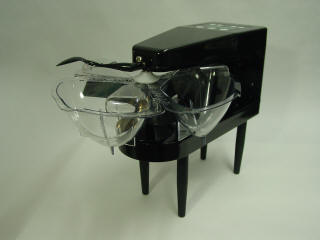
The Mealtime Partner Mounted on 6-Inch Legs |
| For additional information, please call us at 800-996-8607, or email our staff for assistance by clicking here. | |
| The Mealtime Partner Assistive Dining Device is available directly from Mealtime Partners, Inc. | |
Introducing the Drink-Partner Drinking System
For more than a decade Mealtime Partners has developed and marketed hands-free drinking systems that accommodate a wide range of user needs and desires. Knowing how important maintaining hydration is, and yet how difficult it is to attain for some people, these products have become just as important to us as our original product: the Mealtime Partner Dining System. Our goal is to provide dining and drinking systems that are flexible, reliable, and easy to use.
Recently, we introduced a new set of products to our line. They are called the Drink-Partner Drinking Systems. The basic product consists of a cup-holder (also used in our Front Mounted Drinking Systems) that holds a 25-ounce water bottle. There are two different types of mounting systems that are available for Drink-Partner systems. One Drink-Partner Drinking System attaches to both manual wheelchairs that have tubular frames (or handles), and to powered wheelchairs that also have tubular frames. The other type fits on powered wheelchairs that have slide-track rails (either standard track or UniTrack). In this way the Drink-Partner Drinking System can be mounted to most wheelchairs regardless of the type of wheelchair, thus making the Drink-Partner available for many users.
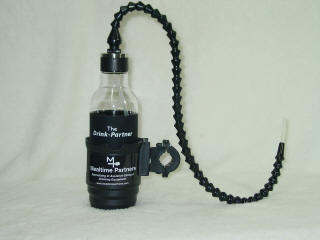
|
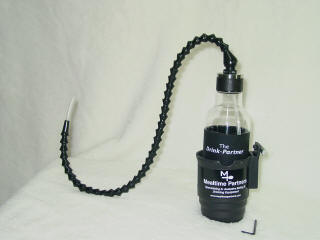
|
| Figure 1: The Drink-Partner Drinking System for Manual Wheelchairs |
Figure 2: The Drink-Partner Drinking System for Wheelchairs with Slide-Track |
Typically, the cup holder is mounted to the back of the wheelchair and the bottle inserted into it. The flex tubing guides the drink tube over the user’s shoulder and positions the tip of the drink tube close to the user’s mouth. The Drink-Partner shown in figure 1 is attached to the wheelchair handle or rail by a clamp that is an integral part of the cup holder. The Drink-Partner shown in figure 2 uses a T-Nut that fits into the slide-track to mount it.
The Drink-Partner bottle is clear (i.e., transparent) to enable the person using it to see what is in the bottle and how full it is. Additionally, because it is clear, it is easy for the person who cleans it to see that it is truly clean. The lower part of the bottle is covered by an insulated sleeve. The cap on the top of the bottle is a screw cap with a metal cover on its outside. This is important as the metal significantly reduces the possibility of the cap breaking, which is an ongoing problem for bottles that have plastic caps without reinforcement.
Integrated into the Drink-Partner cap is a vibration resistant, 24-inch length of ball and socket tubing (i.e., flex tubing) which holds the drinking tube (i.e., the straw). The ball and socket tubing positions the end of the drinking tube in an accessible location for the user to be able to drink from it with ease. To purchase the Drink-Partner products, click on the selected photograph.
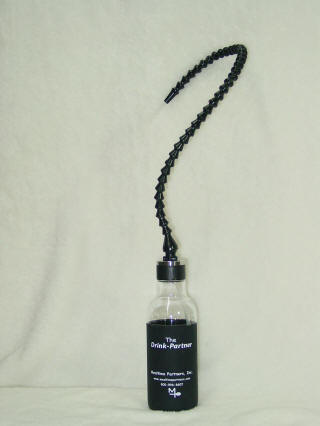
|
| Figure 3: The Drink-Partner Bottle |
| Did You Know? Did you know that being overweight not only impacts your health but is expensive? Researchers from The Global Obesity Prevention Center at Johns Hopkins University recently published a study describing a computer simulation that they conducted that calculated the cost of being overweight when the weight gain was begun at different ages. The simulation calculated the healthcare cost that is incurred by being obese and also the cost of lost productivity caused by obesity. The two figures combined expressed the total societal cost. The simulation looked at costs based on age of excess weight onset and also weight loss over the lifetime of the simulated people. The model was based on information from several different research sources. An example of the finding describes a 20 year old who lost weight, and went from obese to an ideal weight, which would save about $28,000 throughout their lifetime due to their weight loss. |
Mealtime Partners Website Navigation:
Home | Dining | Drinking | All Products | Ordering | Training | Calendar | FAQ | Newsletters | Contact
Please send comments and suggestions to newsletters@mealtimepartners.com
Copyright © Mealtime Partners, Inc. 2017
All rights reserved.
